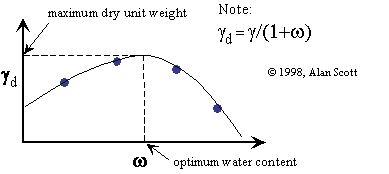
“The Standard Proctor Test is a laboratory test used to determine the optimum water for a given compaction energy, for a given soil. The graph illustrates the results obtained from a Standard Proctor test.
The Proctor compaction test is a laboratory method of experimentally determining the optimal moisture content at which a given soil type will become most dense and achieve its maximum dry density. (Compaction is the process by which the bulk density of an aggregate of matter is increased by driving out air.) The term Proctor is in honor of R. R. Proctor, who in 1933 showed that the dry density of a soil for a given compactive effort depends on the amount of water the soil contains during soil compaction.
These laboratory tests generally consist of compacting soil at known moisture content into a cylindrical mould of standard dimensions using a compactive effort of controlled magnitude. The soil is usually compacted into the mould to a certain amount of equal layers, each receiving a number blows from a standard weighted hammer at a specified height. This process is then repeated for various moisture contents and the dry densities are determined for each. The graphical relationship of the dry density to moisture content is then plotted to establish the compaction curve. The maximum dry density is finally obtained from the peak point of the compaction curve and its corresponding moisture content, also known as the optimal moisture content.”
Owen: In most cases, laboratory tests are not needed for earthbag projects. The information is presented here to highlight the relationship between water content and soil compaction. Too much water will make the soil squishy and temporarily reduce bearing capacity (which could cause a delay in construction as you wait for the earthbags to dry). Too dry and the soil particles won’t thoroughly bond. Perhaps the easiest way to achieve high compaction without testing is to increase the water content (spray with garden hose) until a small amount of water is oozing out of the bags after tamping. Making some test bags is always a good idea. And while you’re at it, you might want to test the clay/aggregate ratio to help create stronger earthbags. For this, see Patti Stouter’s report on Soil Tests for Earthbag. If all this tech talk is starting to scare you off, just remember that most subsoils with at least some clay and a small amount of water will make strong earthbags if thoroughly tamped solid. This video on Adjusting the Moisture Content sums up the basic process.
Source: Wiki
Image source: University of Wisconsin
